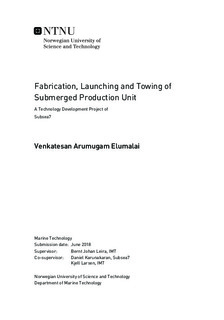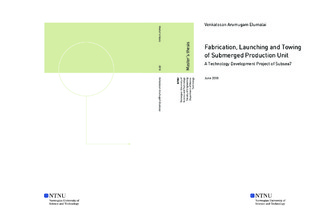| dc.description.abstract | The demand for fossil fuels drives for an advancement in the existing subsea technology. The developments evolved as the search for hydrocarbons moved from onshore to offshore, followed by a transition from shallow to deep and ultra-deep waters. Another huge milestone was achieved when production systems made a transition from topsides to subsea units for efficiency. That being said, there is an enormous drive to minimize the operational costs involved in the processing of hydrocarbons. Researches are underway towards what would be yet another significant feat in the oil and gas industry, which is by moving the processing systems to subsea. One such impressive concept which is being developed, is the Submerged
Production Unit (SPU).
This study is an initial attempt to investigate the challenges associated with the SPU focusing on the factors influencing fabrication, launching and towing. This thesis revolves around finding an optimized solution for the challenges associated with the integration of Glass Reinforced Plastic (GRP) and subsea buoyancy material for the assembly, which is one of the main objectives of this thesis. Industrial visits to GRP fabricator, subsea buoyancy material fabricator and the assembly yard coupled with inputs from Subsea 7 engineers, formed the base for this research work. A design concept that goes back and forth from performance and design spaces was used in solving the complexity that revolved around SPU assembly. Analytical Hierarchy Process (AHP), an effective tool dealing with complex decision making was used to decide the best possible location for assembly and launching of the SPU. Finally, OrcaFlex software was used for towing analysis. End force in global X direction on towline, obtained from static analysis was used to identify the Bollard Pull (BP) required for towing the SPU. Dynamic analysis was performed for different environment conditions to identify the maximum effective tension on the towline.
The research work resulted in the development of a 3D Joint, using Autodesk Inventor software for the SPU assembly. This joint provided a one way access to connect all the SPU sub assemblies. The AHP suggested the use of syncrolift for launching the SPU by making pairwise comparisons between the yards chosen and the evaluation criteria cost, safety, fabrication facilities and commissioning facilities. BP requirement of 100T was estimated from static analysis. The maximum effective tension experienced on the lead tug towline was 837KN for waves in 180°, wave period of 20s, wave height of 7m along with current in 90°at a speed of 1m/s. | |

